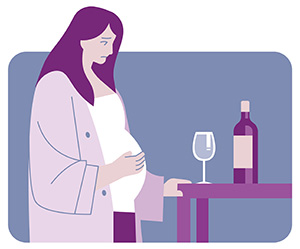By Diana Ling, MA, and Anna Mangum, MSW, MPH

Since the start of the COVID-19 pandemic, heavy drinking among women has increased by an alarming 41 percent, compared with a 7 percent increase among men, according to a study in JAMA Network Open. These findings add to an already troubling increase in alcohol use among women well before the pandemic.
A review of six national surveys found that the number of women who drink rose by 6 percent between 2000 and 2016, while binge drinking among women increased by 14 percent. Rising alcohol use comes with increases in alcohol-related health risks, injuries and chronic conditions, and harmful health effects can occur more rapidly in women and be more severe than they are in men.
Women also face unique risks to reproductive health and birth outcomes, including alcohol-exposed pregnancy and fetal alcohol spectrum disorders (FASDs), a range of lifelong impairments that can occur in a person who was exposed to alcohol before birth. These issues can include problems with behavior, learning and physical development. Prenatal alcohol exposure is the most common preventable cause of intellectual and developmental delay and disabilities in the United States, and fetal alcohol spectrum disorders (FASDs) may affect up to 1 in 20 U.S. school children.
In fact, nearly 14 percent of pregnant people reported current drinking and about 5 percent reported binge drinking in the past 30 days, according to a 2022 Centers for Disease Control and Prevention (CDC) report. Another study showed both current alcohol use and binge drinking among those who were pregnant increased from 2.5 percent to 4 percent between 2011 and 2018. These patterns of high-risk drinking, together with the alarming prevalence of FASDs, highlight the critical need for prevention strategies.
Since 2014, the Health Behavior Research and Training Institute (HBRT) at The University of Texas at Austin (UT-Austin) Steve Hicks School of Social Work has partnered with NASW to address this leading public health issue and represent social work in CDC’s Collaborative for Alcohol-Free Pregnancy, a collective of national professional organizations that also includes family physicians, medical assistants, nurses, obstetrician-gynecologists, and pediatricians.
HBRT and NASW’s most recent collaboration is “Reaching Healthcare Professionals in the Prevention of FASDs,” a four-year project that began in 2018. Under the direction of primary investigators and HBRT leaders Drs. Mary M. Velasquez and Kirk von Sternberg, the HBRT and NASW teams have worked together to increase social workers’ knowledge about risky alcohol use, including any alcohol use during pregnancy; increase awareness of the importance of talking with clients about risky alcohol use; and increase the use of alcohol SBI (screening and brief intervention) in social workers’ practice settings. Highlights of this collaboration include:
- Establishing a multidisciplinary champions program at UT-Austin to train health social workers in alcohol SBI, including a partnership with UT-Austin’s Dell Medical School’s Department of Health Social Work;
- Publishing a wide range of NASW communications, including clinically focused articles on prenatal alcohol use, alcohol SBI, and FASDs (See resources at end of article);
- Authoring an entry on FASDs for Oxford Bibliographies in Social Work, a peer-reviewed online reference for clinicians, researchers and students (See resources);
- Exhibiting at the 2018 and 2022 NASW national conferences in Washington, D.C.; and
- Developing and implementing a survey on knowledge, attitudes, practices, and training needs related to risky alcohol use.
The survey of 1,387 social workers was conducted in February 2022. More than 70% said they provide services to women of reproductive age; respondents were not asked to define the type of setting they practice in or their specific professional role. A majority of respondents said they have protocols for risky alcohol use screening, though nearly a third said they rarely talk to clients or patients about their alcohol use.
In addition, the majority of social workers did not know the definition of a standard drink (14 grams of pure alcohol, the equivalent of 12 ounces of beer, 5 ounces of wine, or 1.5 ounces of liquor), or the drinking levels considered to be a risk to a woman’s health (more than three drinks per day or more than seven drinks per week for a woman who isn’t pregnant).
These findings indicate a significant opportunity to strengthen training and education on risky alcohol use. As the largest provider of mental and behavioral health services, social workers are well positioned to play a leading role in primary prevention of risky drinking and alcohol-exposed pregnancies. A key message to share with clients is that there is no known safe amount, no safe time, and no safe type of alcohol use during pregnancy. Social workers also can make a difference by screening all adult clients for alcohol use, as recommended by the U.S. Preventive Services Task Force.
HBRT and UT-Austin will continue to support training and education for social workers on these topics through additional funding from the CDC through 2026. The new project will target prenatal use of marijuana, opioids and tobacco in addition to alcohol. Activities will include recruiting NASW members nationwide to join the existing SBI champions network, and strengthening collaboration between NASW and cross-discipline partners.
“Social workers are essential to this effort,” said Velasquez, director of HBRT. “Social workers provide services in the widest range of settings, and also have the specific expertise to support clients in conversations about substance use and healthy pregnancies.”
Resources